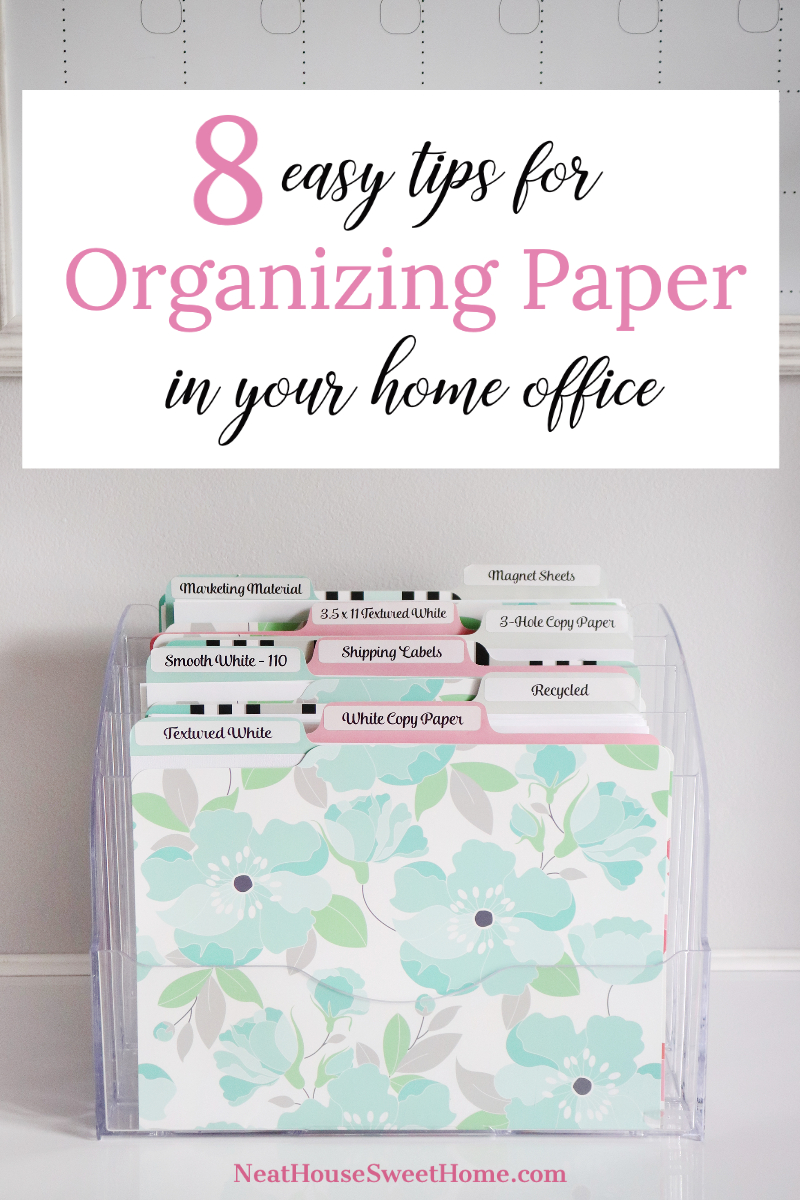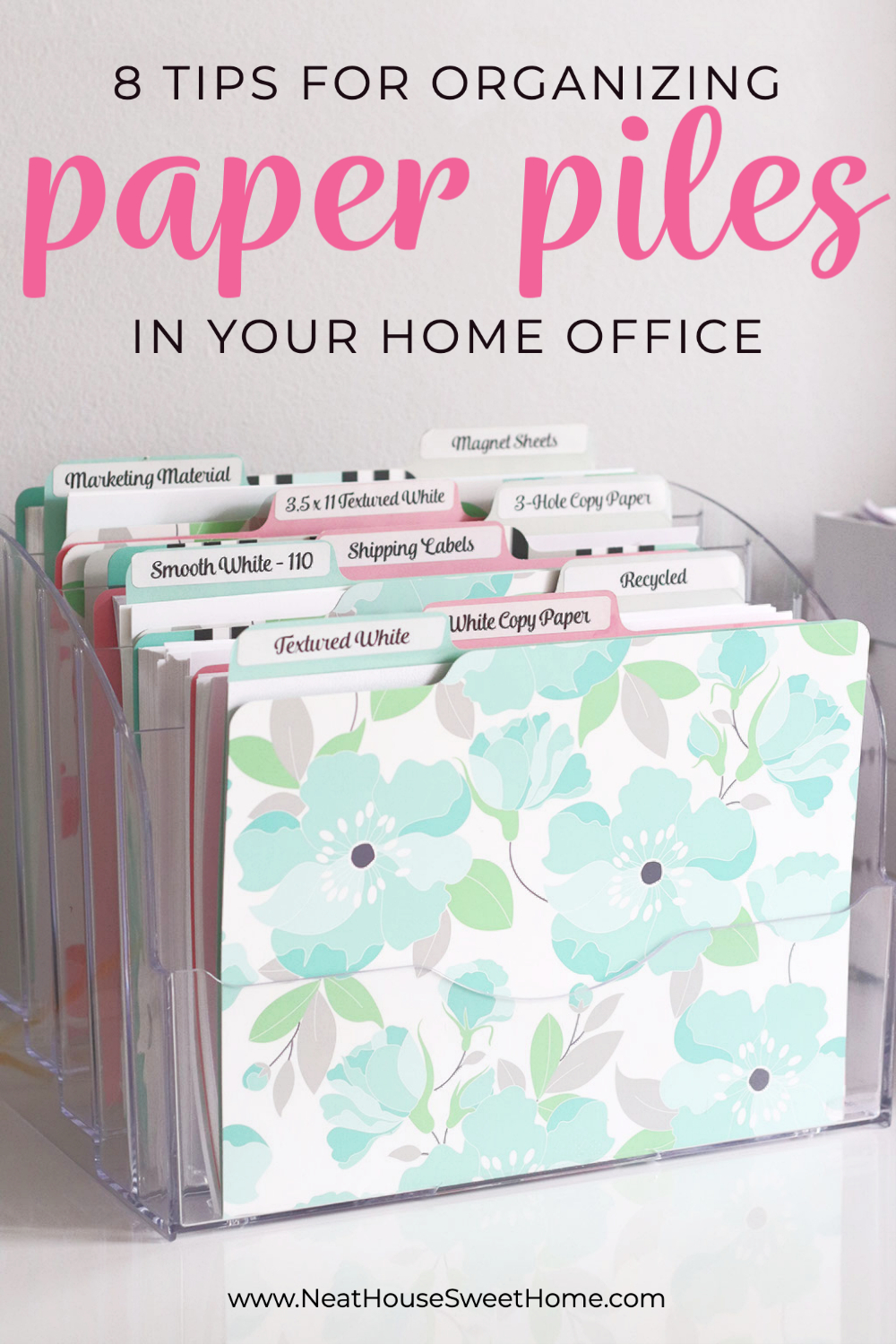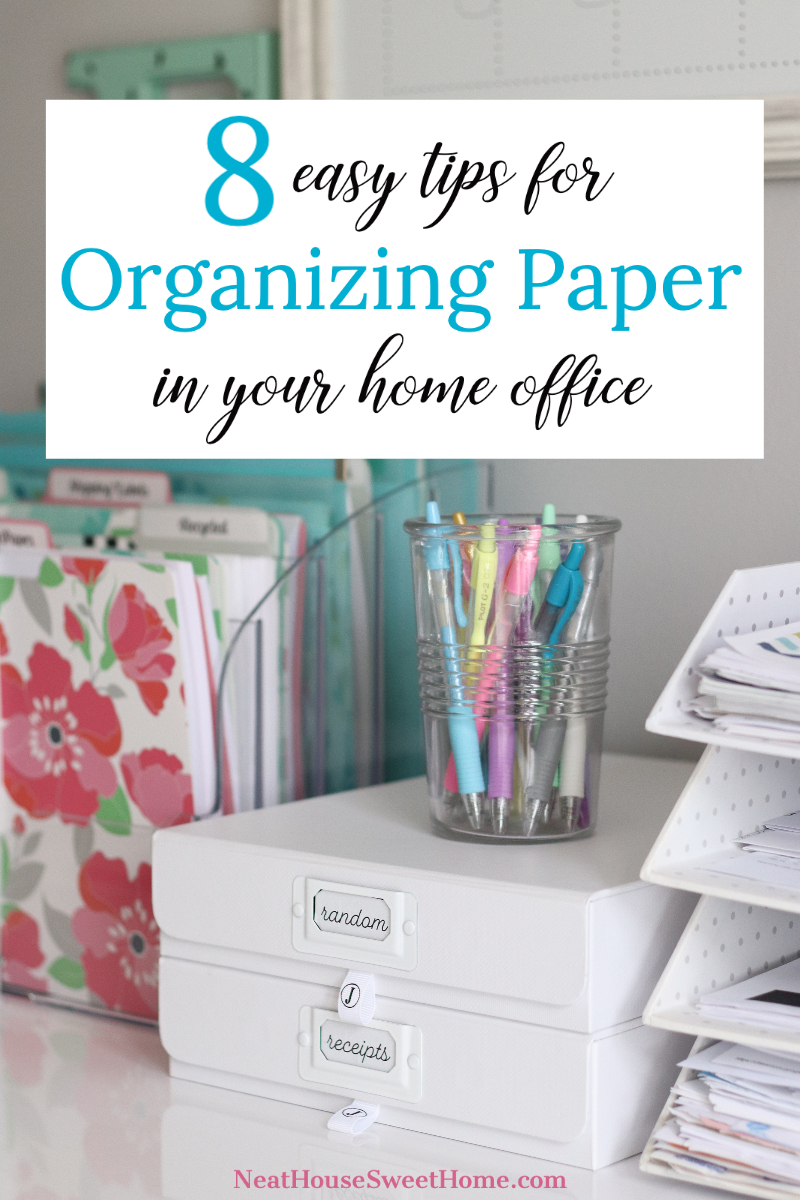8 Tips for Organizing Paper at Home
If paper clutter follows you everywhere, and you are wondering how to deal with those paper piles at home, search no more. Here are my top 8 tips for organizing paper at home, and how to keep a tidy home office.
It seems like I always have a paper pile to deal with. As hard as I try to get rid of papers, paper clutter always finds its way back to my desk. Today, I am sharing my tips for organizing paper, along with some quick office organization ideas and my favorite products.
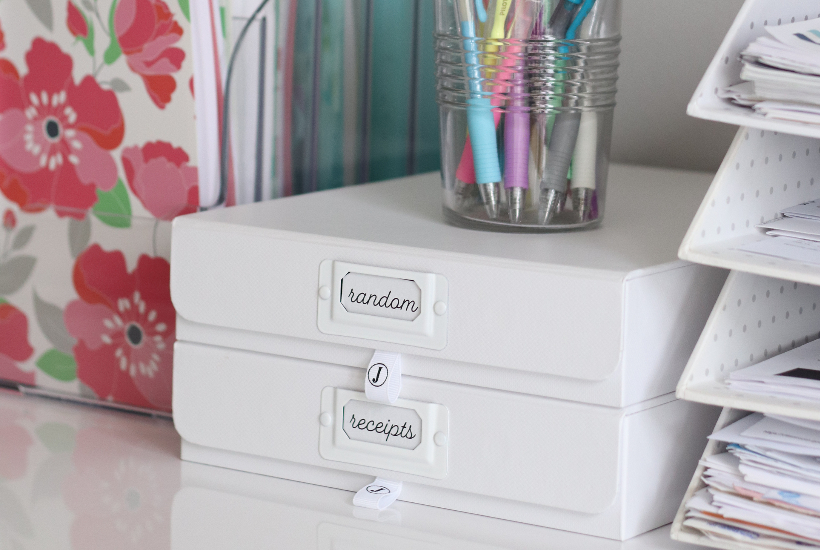
Last week, my friend Heather from Local Mom Scoop invited me to share my tips and tricks on keeping paper organized in the home office. I did a 30-min Facebook Live and shared my golden rules to help you stop the paper clutter.
Home Office Organization Tips
Paper piles can quickly grow if we do not assess them promptly. Throughout the years, to keep my desk free of paper clutter, I have developed a system that helps me keep those paper piles as low as possible.
This system is not magic and doesn’t rid your home of papers. As digital as the world currently is, there will always be papers to print and papers to file. However, if you follow these tips to organize all the paper that enters your home, I promise you will see an improvement.
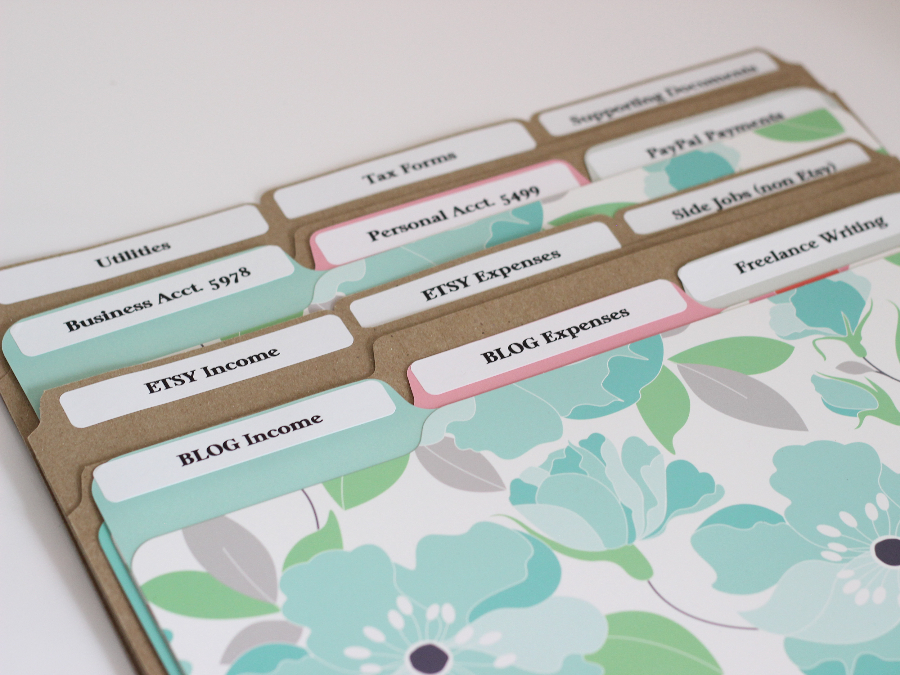
So here are my 8 tips to help you manage paper clutter and keep those paper piles as low as possible in your home office and home in general.
This post contains affiliate links for your convenience. For more information, please read my Affiliates Disclosure.
1. Address Your Papers Promptly
Clutter is the result of postponed decisions. And paper piles are nothing but the result of procrastination. Paper clutter has its roots in leaving it behind to be handled ‘later.’
Facebook Live Min 6:58
To begin with, my first tip for organizing papers at home and avoiding paper piles is to assess them promptly. By promptly, I mean ‘here and now’ as soon as it falls in your hands. Do not postpone the decision. This way, you don’t have to deal with a bigger pile of papers at a later time.
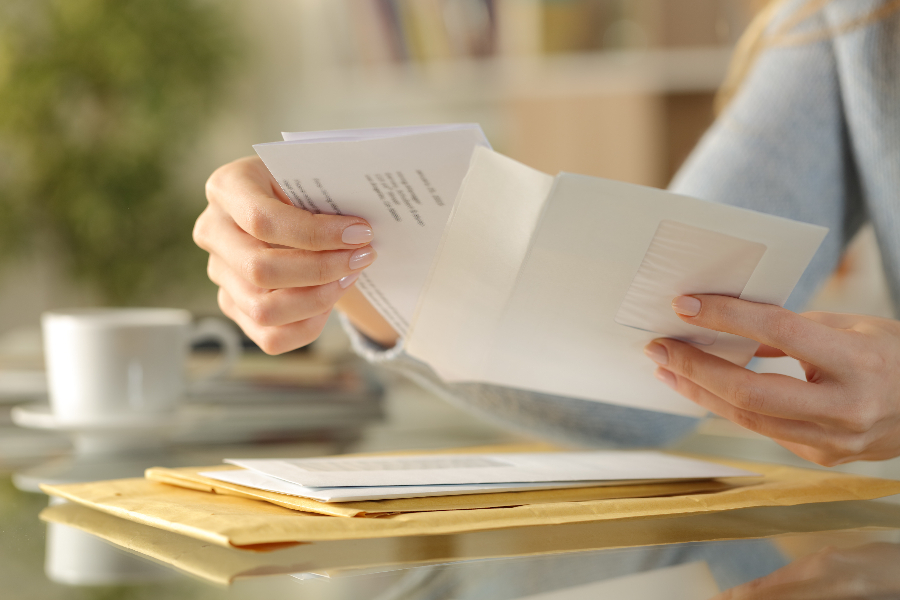
First and foremost, get in the habit of checking your mail around the same time each day. Pick a time of the day when you can spare 5-10 minutes to sort through it and discard whatever needs to be discarded. Do NOT place your mail on the kitchen counter or the coffee table or in a random drawer.
The first step towards an organized home office is only to bring in what belongs in it and nothing else. So, sort your mail and papers before bringing them to your desk. Keep only bills, statements, greeting cards, invitations, letters, or postcards from loved ones.
Pro Tip: Many papers come from school, too, in your children’s folders. Address those as soon as they bring them home.
2. Discard Catalogs and Mailers
When you are dealing with paper, here’s a very important tip: have a clear vision of what papers need organizing and which ones you can discard. Your home office will be organized and neat if you only bring in papers that are absolutely necessary and important.
Facebook Live Min 8:29
I made it a habit to toss every flyer and store catalog that I find in my mailbox. Here are three reasons why you should too:
- Your time is precious. Don’t waste it going through catalogs’ pages. You look at things you don’t need, but they want you to ‘want it’ because it’s on sale.
- There will always be a sale. Always. Chances are, you probably don’t need whatever is on sale today. So don’t spend money on something just because it’s on sale.
- If the need arises, you can always look up the same sales and coupons on the store’s website or app.
3. Recycle All Coupons And Go Digital
Recycling paper clutter is always a good idea. Not only is it a good tip for organizing your papers and home office, but also for caring for our environment. So, recycle all those coupons and flyers and go digital. Let the paper recycling company deal with that pile!

Keep mailers or coupons from local stores or restaurants if, and only if, you know there is not a digital option. Make sure to have a special place for those coupons. Hint: that place is not your desk! Your home office will thank you if you do not bring random paper clippings to your desk.
Keep those coupons inside a coupon wallet just like this one. And keep the coupon wallet inside your car. I used to clip coupons and carry a coupon wallet. Now I use digital coupons and save them in my digital wallet. If there is a physical coupon that I want to save, I place it in my car’s glove compartment.
Do not bring them inside your home or home office. If you need it when you are out and about, chances are you are driving your car. So keep that coupon wallet handy.
4. Sort Papers Into Categories
Once you have discarded papers that are not important or useful, it’s time to sort them into categories. Every household is different, and everyone has different ways of organizing their papers.
Facebook Live Min 11:49
Some families may not have an actual home office, so it is even more important for them to come up with a good organizing method. Whether you have a home office or not, organizing paper into categories is crucial to avoid a cluttered pile later on.
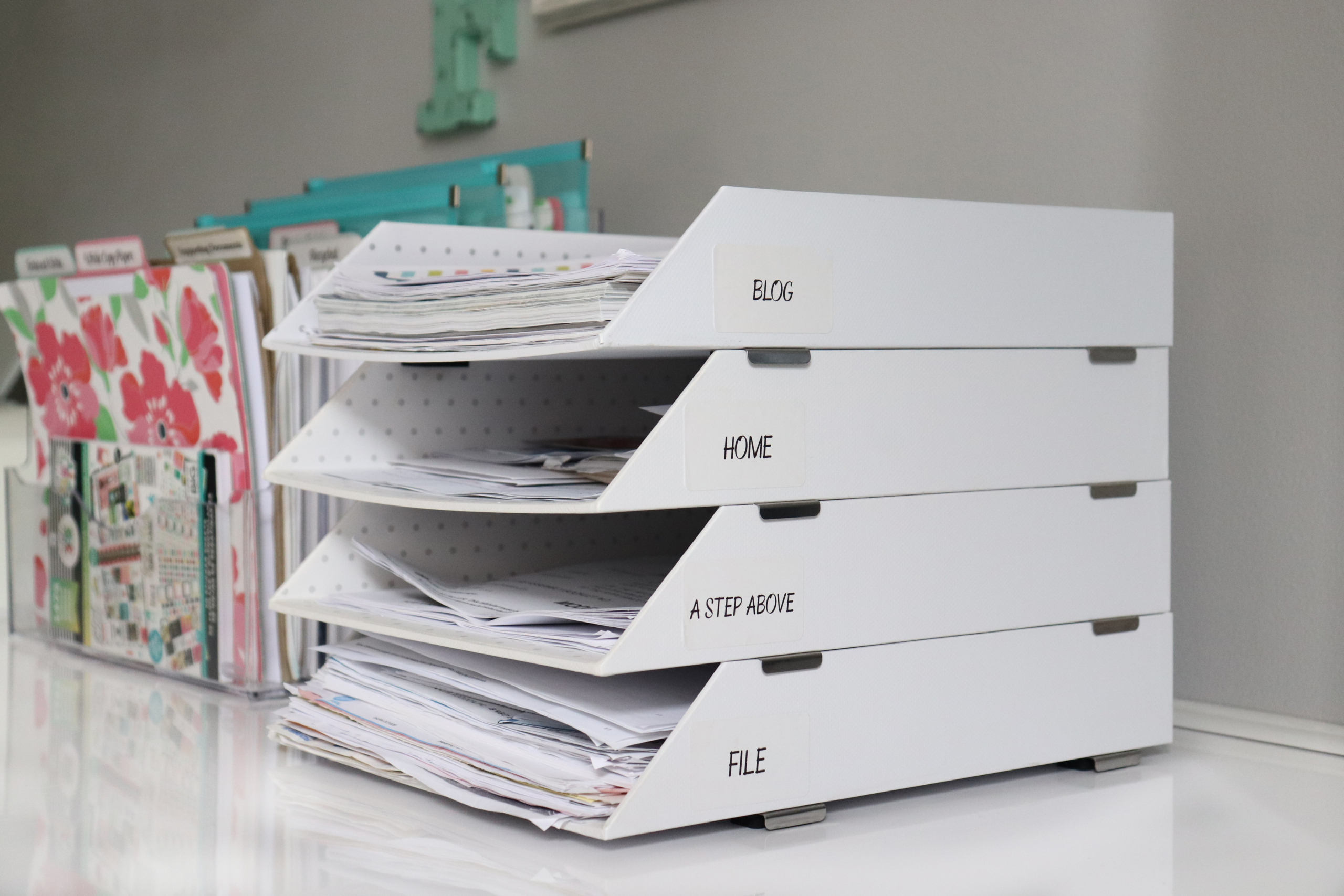
You can have as many categories as you need, but the golden rule of organizing paperwork is to have 2 to 3 paper trays or bins labeled as follows:
- To Do: This is your tray of papers that require some action. A few examples are bills to pay, school forms that need to be signed and returned, and invitations that need an RSVP, among others.
- To File: This tray will hold (for the most part) essential papers that need saving for future reference.
- To Shred: I like to keep a small bin where I toss papers that I do not need anymore but need shredding. Once enough pieces are accumulated to shred, I pick a day and usually ask my son to give me a hand. It keeps him entertained for an hour or so!
These See Jane Work desktop trays I use help me keep paper organized in categories. I love that they are stackable, with a very sleek and clean design. I explained why I have 4 of these paper trays at minute 11:49 on my Facebook Live.
👉🏻 Check out all my favorite things in Office and Stationery
5. Use a Label Maker
If I could only give you one tip for organizing paper at home, it would be this one: use a label maker. Label makers can help you organize anything under the sun, but they are super useful when it comes to paper.
Facebook Live Min 13:29
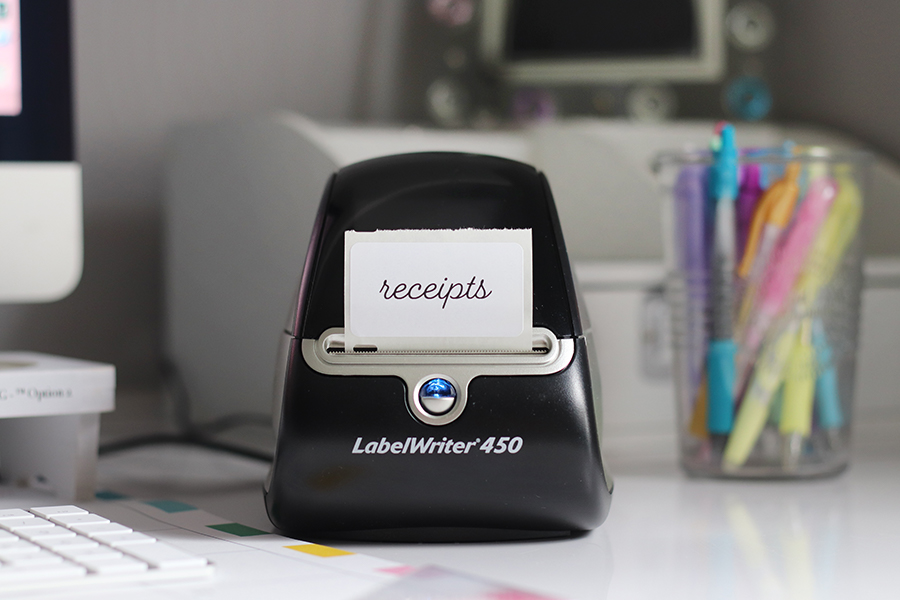
I have been using the Dymo LabelWriter 450 for a few years now, and I love it. It’s compact and straightforward to use. It uses thermal printing technology, which means it does not use ink, which is an excellent feature for me. If you want to learn more about it, read this post.
Facebook Live Min 19:31
My Etsy business requires me to stock a variety of papers for printing, and I need them at the ready. I didn’t want to deal with a bunch of papers piled on my desk or tucked inside a drawer. So, I decided to label them and file them over the desk with this clear multifunctional two-way organizer.
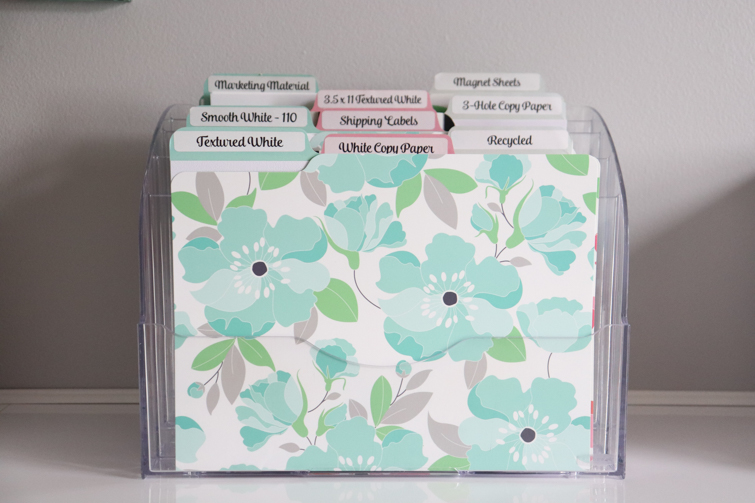
6. Organize Papers by Grouping Them in Binders
This should have been my first tip for organizing papers. Because I love creating binders. Binders are great for organizing a home office.
This is the main reason why I developed The Neat House Binder™, my very own home management binder where I keep all things homemaking grouped and organized.
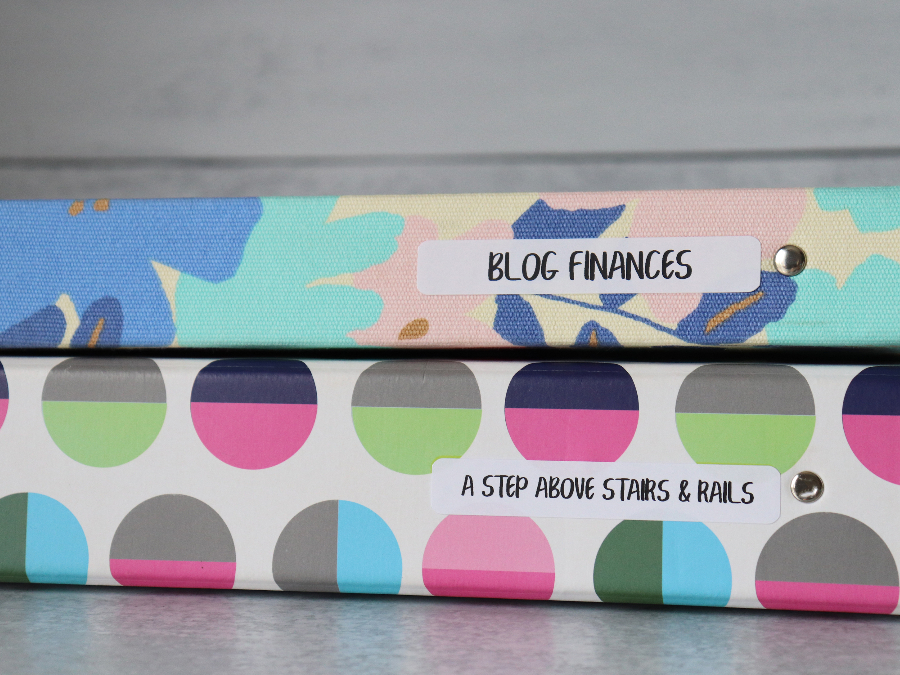
Facebook Live Min 21:26
Binders are good for storing papers that need to be together for quick access and reference. For instance, I have a binder for our stair company. I use index tabs to make categories within the binder and have all the important papers at hand. Whenever I need an account number, a password, or a certificate, all I have to do is pull the binder from my bookshelf.
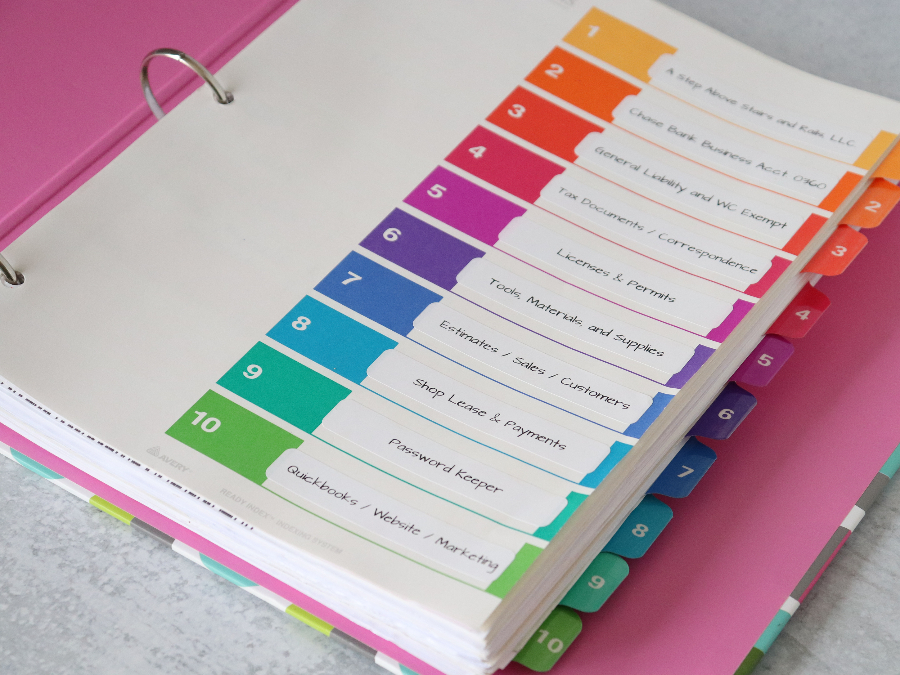
You can make recipe binders, travel binders, school binders (grab a free one here), receipts binders, idea binders, and a household binder; the sky is the limit. All you need to do is gather stranded papers and categorize them. Once you have those groups or categories, punch holes and file them in a binder. Use a zippered pouch for 3-ring binders if you have papers too small for a binder. You can also store important papers that you do not want to punch inside sheet protectors.
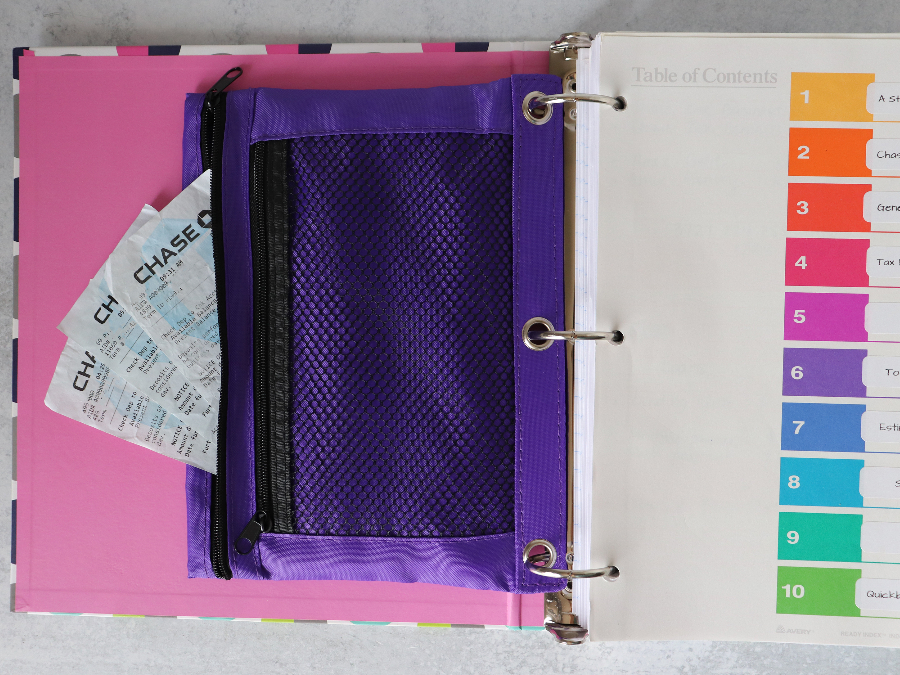
My home office organization is based on the binders principle. If I can group my papers, I make a binder. That way, I do not have to deal with a pile of stranded papers in my home office.
👉🏻 Check out all my favorite things in Office and Stationery
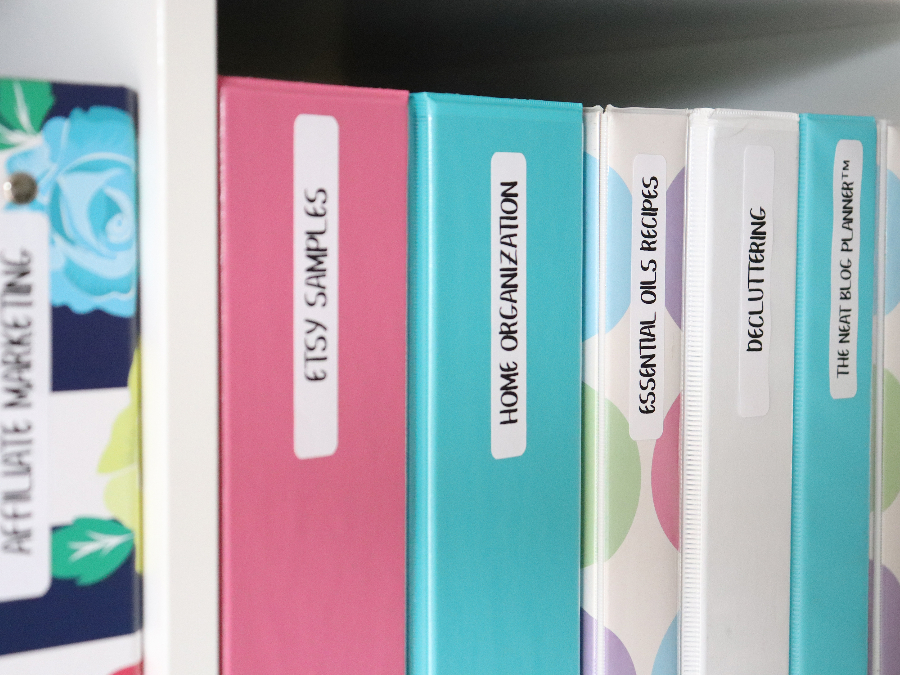
7. Reduce Paper Printing at Home
One of the easiest ways to keep paper organized or at least under control is by printing less. We minimized the incoming mail by signing up for electronic bills and statements. However, I use to print the confirmation/receipt page whenever I posted payments for our bills, creating more papers to file.
Facebook Live 17:45
It wasn’t until a couple of years ago that I realized I could save that payment confirmation page as a PDF in my Google Chrome browser. You can do the same in Safari.
If you want to keep the paper clutter to a minimum, save your online receipts in PDF form. You can categorize them by creating digital folders. I like to make folders for each family member, for the home, and for each one of our businesses. Then I make subfolders.
Here are the instructions on how to save a webpage as a PDF in Chrome. Click here for Safari.
8. Schedule a Time to Organize Paper
One last tip; schedule a day and a time to organize your papers. It is important that you don’t try to do the sorting; take action and file them all on the same day. It’s just not attainable. Here’s what I suggest.
- Every day or every other day: check and sort mail. Keep, discard, and place in your desk trays. If there’s anything urgent that needs your immediate attention, by all means, tend to it.
- Once a week: pick a day and a time to go through your To-Do paper tray and take action. Pay bills or schedule future payments. Once you have taken action, move those papers to the To-File tray.
- Once a month: tackle the papers on the To-File tray. Depending on the amount of paper you hold on to, you might need to file more than once a month. Try once monthly first to see how it goes.
- Once a month: shred all papers you have accumulated in the recycle/shredding bin. Things like pre-screened credit card offers in your name, old bank statements, credit card bills, or any other document you should destroy.
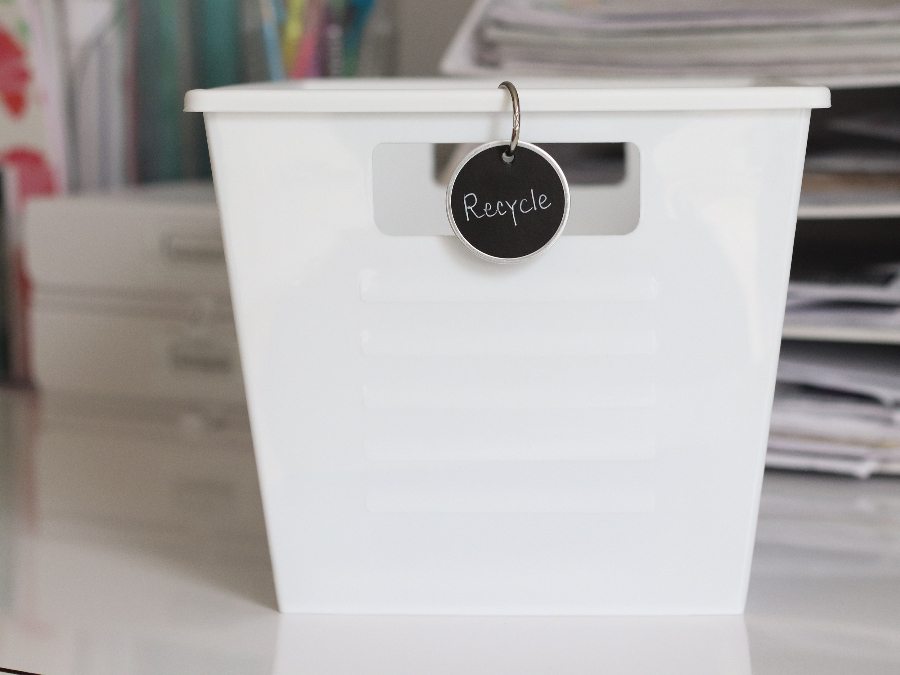
Facebook Live Min 14:51
Dealing with paper piles is not something you can do in a day. By sticking to a schedule to organize your papers, you avoid multitasking and getting pulled in all different ways. Trying to do too many things at once can take you down the rabbit hole. Focusing on one task at a time is far more productive.
I hope you find these tips for organizing your home office and papers useful.

